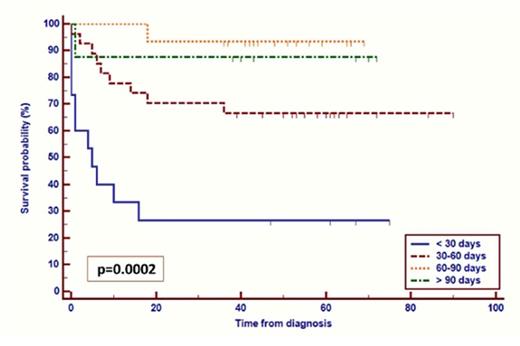Abstract
One hundred and fifty four children with ALL who were admitted in our institution from 2007 to 2013, constituted the study cohort. The aim of our study is to analyze the outcome of children up to 18 years age treated with ALL-BFM 90. The outcomes of children with ALL are shown in Figure 1. Mean age was 10.9 ± 5.3 years (range 1.3 to 18 years). Mean age for boys (11.3 ± 5.1years) was slightly higher than girls (10 ± 5.4 years). Most common ALL in our cohort was Pre B ALL (48%) and it was common (53%) in children less than 10 years. T-ALL was common in children more than 10 years. Hyperdiploidy was the most common cytogenetic abnormality. Hypodiploidy, pseudodiploidy and complex cytogenetics were more common in older children. Philadelphia chromosome was detected in 4 (3.6%) patients. In this study 31 (20.1%) patients either abandoned treatment or lost to follow up mainly due to financial reason.
Standard risk group (SRG) was 83 (64%), medium risk group (MRG) was 34 (24%) and 13 (10%) in high risk group (HRG) in our cohort. Induction mortality and relapse mortality were 28% and 18% respectively. Infection was responsible for 78% of deaths. In our study 3yr EFS was 39.8% ± 3.9% (CI=32% to 47.5%) and 3yr OS was 41.5% ±4.1% (CI=32.1% to 48.6%). SRG had highest EFS (54.6% ± 5.2%) and HRG had lowest EFS (16.3% ± 7.3%) [Figure 2]. Prednisolone good response was a significant prognostic factor by univariate analysis, with a 3yr EFS of 55.4% ±4.8%.
Mean treatment interruption was 69±33 days. Maintenance phase (28±22 days) followed by re-induction phase (16±10 days) were common delay periods. Total interruption of 60 to 90 days had better 3yr [Figure 3] EFS (66.5%±3.3%) than interruption of less than 30 days (25.2%±9.2%).Therapy related cytopenia (with or without fever) and hepatitis were common cause of delay in therapy. Most common adverse effect during treatment was febrile neutropenia (96%) followed by gastrointestinal (72%), hepatitis (48%), central venous catheter related complications (62%).
It is possible to administer a cost effective yet intensive BFM regimen in India and obtain reasonable results in terms of complete remission, moderate mortality and acceptable event free survival. Identification of prognostic variables and biologically defined risk groups will form the basis of further treatment approaches for childhood ALL in India. Reducing the number of patients lost to follow up and providing access to treatment for all children in the developing world is a goal we must continue to strive to achieve.
Flow diagram depicting outcome of children with ALL
3 year EFS in Risk groups
3 year EFS in relation to treatment interruption duration
3 year EFS in relation to treatment interruption duration
No relevant conflicts of interest to declare.
Author notes
Asterisk with author names denotes non-ASH members.




This feature is available to Subscribers Only
Sign In or Create an Account Close Modal